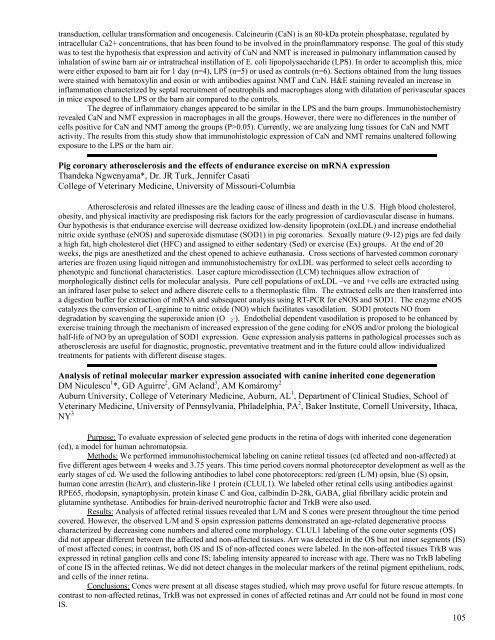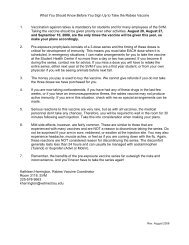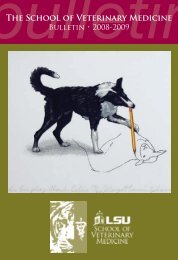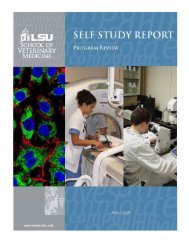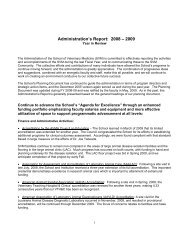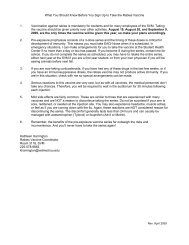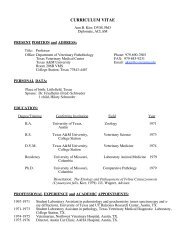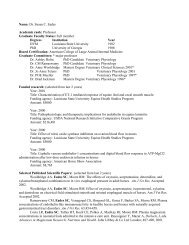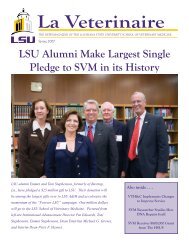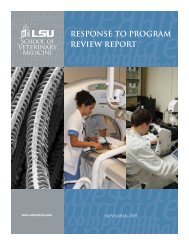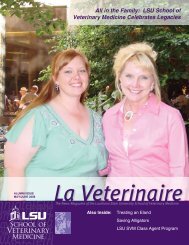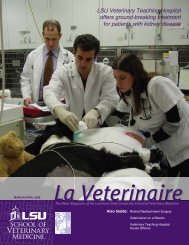control to determine the efficiency <strong>of</strong> transfection. We hypothesize that the cloned CRX promoter will drive expression <strong>of</strong>reporter GFP in a retinoblastoma cell line (Y79) but not in a renal cell line (HEK293). These results would show theeffectiveness <strong>of</strong> using the CRX promoter for photoreceptor-specific gene therapy.Epidermal Growth Factor Promotes the Malignant Phenotype in Canine HemangiosarcomaKatie McDermott*, Barbara Rose, Douglas H. ThammThe Animal Cancer Center, College <strong>of</strong> <strong>Veterinary</strong> <strong>Medicine</strong> and Biomedical Sciences, Colorado <strong>State</strong> UniversityHemangiosarcoma (HSA) is one <strong>of</strong> the most common neoplasms in dogs and is <strong>of</strong>ten very aggressive in behavior.Even with surgical and chemotherapeutic treatments, the prognosis is grave with metastasis very likely. The receptortyrosine kinase EGFR (erbb1), the receptor for epidermal growth factor (EGF) and other related growth factors, mediates avariety <strong>of</strong> oncogenic functions in human epithelial neoplasms. While previous studies have demonstrated the presence <strong>of</strong>EGFR in canine neoplastic tissues, the functional role played by signaling through this receptor has been incompletelystudied, and its presence in HSA has not been evaluated. The goal <strong>of</strong> this study was to determine the in vitro effects <strong>of</strong> EGFon the proliferation, invasion, survival, and chemosensitivity in canine HSA cells, as well as our ability to block those effectsusing the investigational small molecule ZD6474. HSA cell lines used were Den and Fitz, both developed in our lab. EGFdrivengrowth alterations were measured via a bioreductive fluorometric assay (Alamar Blue). VEGF production wasmeasured by ELISA and cell migration assays were preformed using Boyden chamber assays.Under low serum conditions, both canine HSA cell lines proliferated and showed enhanced chemotaxis in responseto rhEGF. Both these responses were blocked by the addition <strong>of</strong> ZD6474. VEGF production by the cells was stimulated bythe addition <strong>of</strong> EGF, and this response was also blocked using ZD6474. Studies are ongoing to evaluate EGF’s effect onanchorage-independent growth, chemotherapy resistance, and phosphorylation <strong>of</strong> downstream targets in response tostimulation with EGF. In conclusion, EGF was shown to stimulate a multiple features promoting the malignant phenotype incanine HSA. Strategies targeting EGFR signaling may hold promise as novel treatments for this common canine cancer.Molecular characterization <strong>of</strong> congenital goiterous hypothyroidism due to thyroid peroxidase deficiency indomestic shorthair catsCatherine V. Morrow*, Anne Traas, Eva Tcherneva, Angela M. Huff, Marisa Van Hoeven, Hamutal Mazrier,Mark E. Haskins, Urs Giger.Section <strong>of</strong> Medical Genetics, <strong>School</strong> <strong>of</strong> <strong>Veterinary</strong> <strong>Medicine</strong>, University <strong>of</strong> Pennsylvania, Philadelphia, PACongenital hypothyroidism (CH) is a group <strong>of</strong> disorders that has been seen in many species including humans, dogs,mice and cats and can either be induced by environmental factors or be inherited. Among the hereditary forms 85% <strong>of</strong>children with CH have thyroid dysgenesis, while the rest have defects in the synthesis <strong>of</strong> thyroid hormone (thyroiddyshormonogenesis). The purpose <strong>of</strong> our study was to characterize the molecular defect in a colony <strong>of</strong> domestic shorthaircats with goiterous CH.Clinical features <strong>of</strong> CH include dwarfism and dullness, known as cretinism, in all species, but also constipation andmegacolon unique to cats. Feline breeding studies documented an autosomal recessive mode <strong>of</strong> inheritance. Affected catsdevelop a goiter and have low serum thyroxine (T4) and triiodothyronine (T3), but high thyroid stimulating hormone levelsindicating thyroid dyshormonogenesis. These cats’ enzyme activity <strong>of</strong> thyroid peroxidase (TPO) was extremely lowcompared to that <strong>of</strong> normal kittens, therefore the TPO gene was the focus <strong>of</strong> our mutation search. Genomic DNA and cDNAfrom affected, carrier, and normal cats was extracted and sequenced based upon primers developed from the feline genomedatabase. Thus far we have >90% <strong>of</strong> the TPO cDNA sequenced and two polymorphisms were discovered compared to thecorresponding feline genome sequence: a change from A to G in the first exon which was also seen in healthy normal catsand an 8 bp deletion seen in intron 9 which might be a unique and disease-causing deletion in hypothyroid cats. Such adeletion may affect splicing and further studies to elucidate the disease-causing mutation are in progress. The sequencing <strong>of</strong>the TPO gene and discovery <strong>of</strong> a TPO mutation in one family might lead to a simple genetic test that will allow screening <strong>of</strong>the cat population for this serious but treatable endocrinopathy. Cats with hereditary TPO deficiency may also serve asmodel to investigate novel therapies for CH. Supported by NIH RR02512.N-myristoyltransferase and calcineurin expression in normal and inflamed lungsKai-Fong Ng, Chandrashekhar Charavaryamath and Baljit SinghImmunology Research Group and <strong>Veterinary</strong> Biomedical Sciences, University <strong>of</strong> Saskatchewan, Saskatoon, SKS7N 5B4Previous studies have shown that exposure to swine barn air induces lung inflammation characterized by increasedrecruitment <strong>of</strong> neutrophils and eosinophils and an increase in the number <strong>of</strong> airway epithelial goblet cells. However, themechanisms <strong>of</strong> inflammation and cell recruitment following barn exposure have yet to be elucidated. N-myristoyltransferase(NMT) causes the myristoylation, acylation through the amide linkage to the N-terminal glycine residue <strong>of</strong> proteins, which inturn regulates both protein function and localization. Myristoylated proteins have been found to be involved in signal104
transduction, cellular transformation and oncogenesis. Calcineurin (CaN) is an 80-kDa protein phosphatase, regulated byintracellular Ca2+ concentrations, that has been found to be involved in the proinflammatory response. The goal <strong>of</strong> this studywas to test the hypothesis that expression and activity <strong>of</strong> CaN and NMT is increased in pulmonary inflammation caused byinhalation <strong>of</strong> swine barn air or intratracheal instillation <strong>of</strong> E. coli lipopolysaccharide (LPS). In order to accomplish this, micewere either exposed to barn air for 1 day (n=4), LPS (n=5) or used as controls (n=6). Sections obtained from the lung tissueswere stained with hematoxylin and eosin or with antibodies against NMT and CaN. H&E staining revealed an increase ininflammation characterized by septal recruitment <strong>of</strong> neutrophils and macrophages along with dilatation <strong>of</strong> perivascular spacesin mice exposed to the LPS or the barn air compared to the controls.The degree <strong>of</strong> inflammatory changes appeared to be similar in the LPS and the barn groups. Immunohistochemistryrevealed CaN and NMT expression in macrophages in all the groups. However, there were no differences in the number <strong>of</strong>cells positive for CaN and NMT among the groups (P>0.05). Currently, we are analyzing lung tissues for CaN and NMTactivity. The results from this study show that immunohistologic expression <strong>of</strong> CaN and NMT remains unaltered followingexposure to the LPS or the barn air.Pig coronary atherosclerosis and the effects <strong>of</strong> endurance exercise on mRNA expressionThandeka Ngwenyama*, Dr. JR Turk, Jennifer CasatiCollege <strong>of</strong> <strong>Veterinary</strong> <strong>Medicine</strong>, University <strong>of</strong> Missouri-ColumbiaAtherosclerosis and related illnesses are the leading cause <strong>of</strong> illness and death in the U.S. High blood cholesterol,obesity, and physical inactivity are predisposing risk factors for the early progression <strong>of</strong> cardiovascular disease in humans.Our hypothesis is that endurance exercise will decrease oxidized low-density lipoprotein (oxLDL) and increase endothelialnitric oxide synthase (eNOS) and superoxide dismutase (SOD1) in pig coronaries. Sexually mature (9-12) pigs are fed dailya high fat, high cholesterol diet (HFC) and assigned to either sedentary (Sed) or exercise (Ex) groups. At the end <strong>of</strong> 20weeks, the pigs are anesthetized and the chest opened to achieve euthanasia. Cross sections <strong>of</strong> harvested common coronaryarteries are frozen using liquid nitrogen and immunohistochemistry for oxLDL was performed to select cells according tophenotypic and functional characteristics. Laser capture microdissection (LCM) techniques allow extraction <strong>of</strong>morphologically distinct cells for molecular analysis. Pure cell populations <strong>of</strong> oxLDL –ve and +ve cells are extracted usingan infrared laser pulse to select and adhere discrete cells to a thermoplastic film. The extracted cells are then transferred intoa digestion buffer for extraction <strong>of</strong> mRNA and subsequent analysis using RT-PCR for eNOS and SOD1. The enzyme eNOScatalyzes the conversion <strong>of</strong> L-arginine to nitric oxide (NO) which facilitates vasodilation. SOD1 protects NO fromdegradation by scavenging the superoxide anion (O 2·). Endothelial dependent vasodilation is proposed to be enhanced byexercise training through the mechanism <strong>of</strong> increased expression <strong>of</strong> the gene coding for eNOS and/or prolong the biologicalhalf-life <strong>of</strong> NO by an upregulation <strong>of</strong> SOD1 expression. Gene expression analysis patterns in pathological processes such asatherosclerosis are useful for diagnostic, prognostic, preventative treatment and in the future could allow individualizedtreatments for patients with different disease stages.Analysis <strong>of</strong> retinal molecular marker expression associated with canine inherited cone degenerationDM Niculescu 1 *, GD Aguirre 2 , GM Acland 3 , AM Komáromy 2Auburn University, College <strong>of</strong> <strong>Veterinary</strong> <strong>Medicine</strong>, Auburn, AL 1 , Department <strong>of</strong> Clinical Studies, <strong>School</strong> <strong>of</strong><strong>Veterinary</strong> <strong>Medicine</strong>, University <strong>of</strong> Pennsylvania, Philadelphia, PA 2 , Baker Institute, Cornell University, Ithaca,NY 3Purpose: To evaluate expression <strong>of</strong> selected gene products in the retina <strong>of</strong> dogs with inherited cone degeneration(cd), a model for human achromatopsia.Methods: We performed immunohistochemical labeling on canine retinal tissues (cd affected and non-affected) atfive different ages between 4 weeks and 3.75 years. This time period covers normal photoreceptor development as well as theearly stages <strong>of</strong> cd. We used the following antibodies to label cone photoreceptors: red/green (L/M) opsin, blue (S) opsin,human cone arrestin (hcArr), and clusterin-like 1 protein (CLUL1). We labeled other retinal cells using antibodies againstRPE65, rhodopsin, synaptophysin, protein kinase C and Goa, calbindin D-28k, GABA, glial fibrillary acidic protein andglutamine synthetase. Antibodies for brain-derived neurotrophic factor and TrkB were also used.Results: Analysis <strong>of</strong> affected retinal tissues revealed that L/M and S cones were present throughout the time periodcovered. However, the observed L/M and S opsin expression patterns demonstrated an age-related degenerative processcharacterized by decreasing cone numbers and altered cone morphology. CLUL1 labeling <strong>of</strong> the cone outer segments (OS)did not appear different between the affected and non-affected tissues. Arr was detected in the OS but not inner segments (IS)<strong>of</strong> most affected cones; in contrast, both OS and IS <strong>of</strong> non-affected cones were labeled. In the non-affected tissues TrkB wasexpressed in retinal ganglion cells and cone IS; labeling intensity appeared to increase with age. There was no TrkB labeling<strong>of</strong> cone IS in the affected retinas. We did not detect changes in the molecular markers <strong>of</strong> the retinal pigment epithelium, rods,and cells <strong>of</strong> the inner retina.Conclusions: Cones were present at all disease stages studied, which may prove useful for future rescue attempts. Incontrast to non-affected retinas, TrkB was not expressed in cones <strong>of</strong> affected retinas and Arr could not be found in most coneIS.105
- Page 1 and 2:
2006 MERCK/MERIALNATIONAL VETERINAR
- Page 6 and 7:
3:00-3:30 pm BreakNovel therapy for
- Page 8 and 9:
KEYNOTE SPEAKERRonald Veazey, D.V.M
- Page 10 and 11:
Mini Symposium II:Fish Research: A
- Page 12 and 13:
David G. Baker, D.V.M., M.S., Ph.D.
- Page 14 and 15:
Konstantin G. Kousoulas, Ph.D.Profe
- Page 16 and 17:
Joseph Francis, B.V.Sc., M.V.Sc., P
- Page 18 and 19:
dogs with cancer, the potential rol
- Page 20 and 21:
2006 MERCK/MERIALVETERINARY SCHOLAR
- Page 22 and 23:
YOUNG INVESTIGATOR AWARD HONORABLE
- Page 24 and 25:
Mammary epithelial-specific deletio
- Page 26 and 27:
2006 MERCK/MERIALVETERINARY SCHOLAR
- Page 28:
Variation in Q-Tract Length of the
- Page 34:
Novel therapy for humoral hypercalc
- Page 38:
ALTERNATE:Micron-scale membrane sub
- Page 42 and 43:
ABSTRACT TITLES LISTED BY CATEGORY
- Page 44 and 45:
19. A pilot study of cigarette smok
- Page 46 and 47:
36. Development of a murine in vitr
- Page 48 and 49:
ABSTRACT TITLES LISTED BY CATEGORY
- Page 50 and 51:
71. Identification and characteriza
- Page 52 and 53:
85. Age and Gender Influence Ventil
- Page 54 and 55: ABSTRACT TITLES LISTED BY CATEGORY
- Page 56 and 57: 2006 MERCK/MERIALVETERINARY SCHOLAR
- Page 58 and 59: 10. Preliminary estimation of risk
- Page 60 and 61: ABSTRACT TITLES LISTED BY CATEGORY
- Page 62 and 63: 47. Osteoprotegerin and Receptor Ac
- Page 64 and 65: 61. A Comparison of Interaction Pat
- Page 66 and 67: ABSTRACT TITLES LISTED BY CATEGORY
- Page 68 and 69: ABSTRACT TITLES LISTED BY CATEGORY
- Page 70 and 71: ABSTRACT TITLES LISTED BY CATEGORY
- Page 72 and 73: 2006 MERCK/MERIALVETERINARY SCHOLAR
- Page 74 and 75: used to label avian heterophils for
- Page 76 and 77: obtained via analysis of time and d
- Page 78 and 79: 0.71mg/dL; p=0.001). Values for hem
- Page 80 and 81: mass and fecundity in prespawning w
- Page 82 and 83: Equine Hoof Laminae Tissue Collecti
- Page 84 and 85: Aspiration Pneumonia in DogsDavid A
- Page 86 and 87: Distortion Product Otoacoustic Emis
- Page 88 and 89: tyrosine phosphorylation is measure
- Page 90 and 91: the gravid and non-gravid females t
- Page 92 and 93: egulatory function as its ortholog,
- Page 94 and 95: PATHOLOGY, TOXICOLOGY, AND ONCOLOGY
- Page 96 and 97: Markers of Oxidative Stress in plas
- Page 98 and 99: has been isolated from all samples
- Page 100 and 101: Matrix metalloproteinase secretion
- Page 102 and 103: Reproductive performance, neonatal
- Page 106 and 107: Enhancing the Quality and Reliabili
- Page 108 and 109: grade II MCTs into groups with good
- Page 110 and 111: Transcriptional Regulation of the I
- Page 112 and 113: MICROBIOLOGY AND IMMUNOLOGY (SESSIO
- Page 114 and 115: colonization of the mutant and 6 re
- Page 116 and 117: digestive tracts of these and other
- Page 118 and 119: 100 pfu BRSV. The results show that
- Page 120 and 121: Inhibition of Microneme Secretion i
- Page 122 and 123: Adherent bacilli were present in th
- Page 124 and 125: isolated to analyze cytokine gene e
- Page 126 and 127: purified, viral RNA was extracted a
- Page 128 and 129: The effects of co-engagement of TLR
- Page 130 and 131: Occurrence of Leptospira Vaccine Fa
- Page 132 and 133: undifferentiated catecholaminergic
- Page 134 and 135: the concept that the greater detoxi
- Page 136 and 137: quantitative PCR using gene targets
- Page 138 and 139: Rotenone Induced Dopamine Neuron De
- Page 140 and 141: decrease in serum cortisol, with a
- Page 142 and 143: and detrimental impacts on the brai
- Page 144 and 145: actions of cells prior to embryo de
- Page 146 and 147: Utilizing cDNA Subtraction to Exami
- Page 148 and 149: expression in unilaterally pregnant
- Page 150 and 151: Salmonella is increased. Poultry sa
- Page 152 and 153: exports. The estimated prevalence o
- Page 154 and 155:
eeding grounds near Minnedosa, MB s
- Page 156 and 157:
(PBMC) were isolated using commerci
- Page 158 and 159:
2006 MERCK/MERIALVETERINARY SCHOLAR
- Page 160 and 161:
Trainees acquire in-depth knowledge
- Page 162 and 163:
comparative pathology and/or resear
- Page 164 and 165:
Department of Veterinary Bioscience
- Page 166 and 167:
PhD, Director, Center for Comparati
- Page 168 and 169:
2006 MERCK/MERIALVETERINARY SCHOLAR
- Page 170 and 171:
MICHIGAN STATEUNIVERSITYJames Crawf
- Page 172:
UNIVERSITY OFPENNSYLVANIALindsay Th


